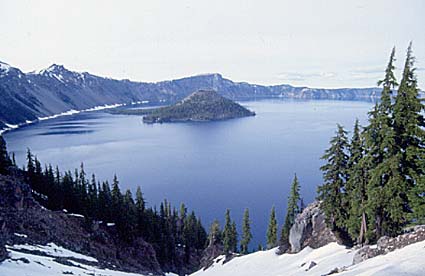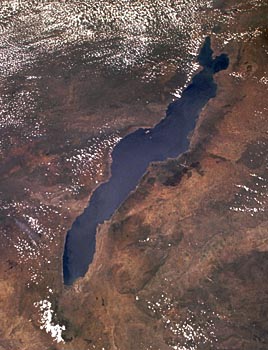lake
A lake is a body of still water not directly connected to the open oceans. Some large lakes are called seas (e.g. Aral Sea).


Crater Lake in Oregon formed in the collapsed crater of a volcano.
You can find lakes all over the world, but especially in regions that have been recently affected by an Ice Age, for example northern Europe and North America. Lakes like these vary from Loch Lomond in Scotland to the Great Lakes (Huron, Michigan, Superior, Ontario, Erie) of North America. They are also found in places where the land has sunk due to the splitting of the Earth's crust, for example the lakes in East Africa (Lake Malawi, Lake Turkana, etc.). Small lakes are also found in ancient volcanic cones. These are called crater lakes (e.g., Crater Lake, Oregon).
Most lakes contain fresh water, but some inland lakes are salty. Examples of salty lakes include the Great Salt Lake of Utah. Salty lakes are found in places where the lakes have no outlet and where the rivers that drain into them cross beds of salty rock.
Lake Superior covers 82,100 sq km and is the largest lake in the world in terms of area. Lake Baikal in Siberia has the largest volume of water, some 23,000 cubic km. The land with the largest density of lakes may be Finland, which has tens of thousands of small lakes. The country with the largest number of lakes may be Canada because it is the largest country to be glaciated.
Lakes are not formed by rivers and they do not last long compared to the history of the Earth. Most have a life of just a few hundred or a few thousand years. After this they become filled in with the sediment brought to them by inflowing rivers.
The upper parts of lakes are good for fish and other water life because there is light, oxygen, heat and nourishment brought in by rivers. But deeper waters have little light and less nourishment or oxygen, and so the number of species at depth is often small.
Lakes are not good at cleaning themselves and so if they become polluted by sewage or waste from factories the life in them may be threatened. Lake Erie, for example, is officially designated as a dead lake due to pollution.
Lakes are very important sources of water for cities, for factories and for irrigation. Where there are insufficient natural lakes people often create them by building dams. An artificial lake is called a reservoir.
Lakes are also often used for transportation, connecting cities that lie on opposite sides of the lake.

These are finger lakes seen from the air. Each lake occupies a glaciated valley. This is the Southern Alps of New Zealand.

This low-oblique, southeast-looking photograph shows Lake Malawi (Lake Nyasa), one of many elongated lakes that form part of the
Great Rift Valley of East Africa. The lake, bounded by steep mountains on all sides except the southern end, is approximately 580km (360 miles) long, averages 40km (25 miles) wide, and has a maximum depth of 706m (2316 feet).
Lake Malawi is drained at the south end by the Shire River, which eventually empties into the Zambesi River.
The lake and its steep-sloped shoreline were created by faulting that caused a thrust upward as the valley floor subsided between the slopes.
The large
Luangwa River basin is visible as it drains to the southwest. Immediately west of the Luangwa River Valley stand the northeast-southwest-trending Muchinga Mountains with their dark
ridgeline and maximum elevations reaching 1800m (6000 feet) above sea level. Northwest of this mountain range, drainage is to the north and west into the much larger Zaire (Congo) River watershed.


|